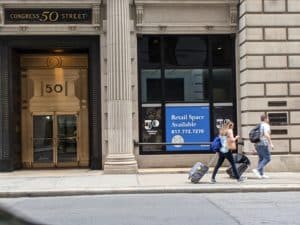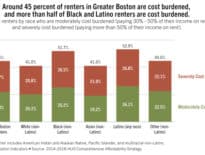
Tourists walk past a vacant retail space on Congress Street in downtown Boston's Financial District in September 2022. Photo by James Sanna | Banker & Tradesman Staff
Boston officials will offer developers density bonuses to build taller buildings that include housing in the downtown area as part of a strategy to revive the central business district.
“Having more people treat downtown as the neighborhood where they live, work and play is a major goal,” BPDA Director and Boston Chief of Planning Arthur Jemison said. “We’re hoping the plan and the incentives and the zoning that come out of this will help put more people on the streets and make it a more vibrant and exciting place.”
Officials will renew its efforts to catalyze redevelopment of public- and privately-owned sites, including the Pi Alley Garage at 275 Washington St., Jemison said.
The privately-owned garage occupies a 33,000-square-foot site and was the subject of preliminary redevelopment discussions in 2016, according to a Boston Herald report at the time.
“That could potentially be a nice tall building site,” Jemison said during a media briefing Wednesday. “There are also proposals out there like the one on Bromfield Street that have been in a bit of a gray area, and now those can get a second look.”
A proposed 22-story office-retail tower at 11-32 Bromfield St. by Midwood Investment & Development has been under review by the BPDA since 2016.
As office work and street traffic have declined to a fraction of pre-pandemic levels, the administration has experimented with stop-gap measures to lure visitors and employees downtown again, including seasonal street festivals.
But the recommendations of a study released today point to the need for larger structural changes that reflect seismic shifts in real estate demand since early 2020.
Incentives for Housing, Retail
The study by Boston Consulting Group also places a priority on converted neglected office buildings into other uses including housing, which has been slow to gain traction in Boston so far. It assesses strategies of other cities grappling with business districts diminished by work-from-home policies and offers more than 30 recommendations.
To generate a bigger 24-hour population downtown, the city’s new acquisition opportunity program could be expanded to subsidize office-to-housing conversions. The program currently is designed to stabilize existing multifamily housing, through owner-occupied acquisitions. Developers that include 40 percent or more affordable units in a project could receive fast-track approvals.
And a multi-million-dollar subsidy program will support businesses renting vacant retail space under a previously-announced initiative.
Fewer than 2,000 housing units have been built in the downtown submarket since 2010, trailing areas such as Back Bay, the Fenway and the Longwood Medical Area. And only 28 percent of the downtown’s current development pipeline is residential.
Developers and architects have been skeptical about the potential for a large wave of office-to-housing conversions, citing the difficulty of breaking up large office floor plates into residential units. Lab conversions remain a more popular option, although real estate researchers predict many of the life science projects will be shelved as financing becomes more difficult in the biotech sector.
The study cited successes in cities such as Philadelphia, which has created more than 1,800 apartments in former commercial spaces in the past two years. To drive the conversions, city officials have offered 10-year tax abatements to building owners and developers.
So far, the city has not budgeted any money to support office-to-residential conversions, but officials expect a consultant they plan to hire will be tasked with coming up with a plan using tax abatements, government funds, affordable housing initiatives, zoning or other tools. The city study also pledges to “partner” with developers, property owners and institutions like Emerson College and Massachusetts General Hospital to identify and remove “unnecessary roadblocks” to housing conversions of class B and C office space.
New Downtown Plan to Clarify Building Heights
One milestone will formally begin on Nov. 9, when a Downtown Crossing event will relaunch of the BPDA’s PLAN: Downtown study with a focus on office conversions.
The study originally launched in 2019, a starkly different environment for downtown commercial real estate, as vacancy rates approached cyclical lows of 7 percent and speculative office towers got under way at properties such as One Congress and The Hub on Causeway.
The planning study area encompasses a wide swath of the core business district from Government Center to the Massachusetts Turnpike, and contemplates potential increases in base building zoning heights. Meetings of an advisory group on the PLAN: Downtown study were put on hold in 2020 amid the pandemic.
The study is also expected to resolve lingering confusion about the multiple regulations that limit downtown building heights, including laws limiting additional shadow on Boston Common and the Public Garden, and Federal Aviation Administration height limits related to Logan International Airport flight patterns.
Occupancy Just One-Third of Pre-COVID Trend
Occupancy of office buildings downtown remains just one-third of the levels prior to the pandemic-induced shift to hybrid and remote work schedules, according to the report.
A separate report released Wednesday by Moody’s Analytics said “cracks have begun to emerge” in Boston’s office market, where vacancies have risen 1.5 percent to 14.3 percent in the past two quarters.
“We’re likely to see a widening of performance distribution at the property level – we’re entering the era of the “haves” and the “have-nots” in the office sector, similar to what we’ve seen in retail over the last five to 10 years,” Moody’s Senior Economist Thomas LaSalvia stated in the report.
Local brokerages recently reported that sublease offerings by current office tenants have hit historic highs exceeding 3.6 million square feet.
The downtown office market’s fortunes are intertwined with the future of urban retail, where a dichotomy has emerged in the past two years.
“Downtown Boston has got a problem, and it all relates to the office market,” said Peter Montesanto, a partner at retail brokerage SRS Real Estate Partners, in an interview this week. “That’s the 800-pound gorilla down there, and that sector has just not come back. The Seaport has sucked a little bit of the life out of the Financial District, but the bigger issue is people just not coming back to [office-based] work.”
The city’s report also cites the need to revitalize Faneuil Hall Marketplace and establish a “shared vision” with the current leaseholder, New York-based Ashkenazy Acquisition Corp., while addressing deferred maintenance at the 46-year-old marketplace. The marketplace’s general manager since 2016, Joseph O’Malley, has left his position, a spokesman for Ashkenazy confirmed on Wednesday, and Ashkenazy project manager Brent Reetz has been named the interim general manager.




 |
| 



